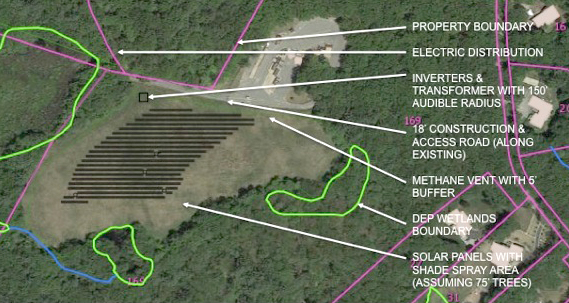They say you can’t make a silk purse out of a sow’s ear, but you might be able to make cheap electricity from garbage—or at least from land on top of garbage.
One of the discussion topics at Saturday’s State of the Town meeting is the idea of putting solar panels on the closed landfill next to the transfer station. If a proposal from Boston-based BlueWave Capital comes to fruition, a solar installation on the site could produce more than 50 percent of Lincoln’s municipal electricity use, according to members of Lincoln’s Green Energy Technology Committee (GETC), which has been studying the idea.
BlueWave has been working with 17 area towns to identify potential sites for solar installations, and the best site they found in Lincoln is the landfill, GETC members explained at the October 19 Board of Selectmen meeting in preparation for the State of the Town. A solar array on the landfill site could generate anywhere from 650 kW to 980 kW, which today would amount to 56 percent of municipal electricity (i.e., power for public schools, town-owned buildings and streetlights).
The town would pay about 12.5 cents per kWh (kilowatt hour) for 20 years with no escalation, compared to the current price of 18-29 cents per kWh depending on the time of year.
“It’s a wonderful opportunity,” said GETC member Paul O’Neil.
But there are many regulatory and legal issues that would have to be resolved before any of this can happen. For example, when the landfill was closed in 1995, the state helped fund the closure in exchange for a promise by Lincoln to restrict future use of the land to open space and conservation, so the state legislature would have to approve an amendment to that restriction.
“Lincoln being who we are, we’ve tightened the screws as much as possible to make it challenging to shift anything,” said GETC member John Snell.
Other legal and policy issues include the lease agreement for the land, possible payment in lieu of taxes for use of the site, the opinions of abutters including the National Park Service, and a “complex web” of federal and state tax credits and deadlines, said Town Administrator Tim Higgins. Lincoln voters will be asked to vote on one or more warrant articles at Town Meeting in spring 2016.
Several other area towns including Acton, Concord, Maynard, Sudbury and Weston have already completed or signed contracts for solar development of town-owned land, GETC member Jennifer Morris said. Capacities range from 1.2 mW in Maynard to 2.25 mW in Weston.
By their very nature, solar arrays need sizable chunks of open space, which Lincoln has in abundance relative to its population, O’Neil noted. In Lincoln, there are about 1.6 acres of protected open space per household, compared to 0.7 acres in Weston, for example.
“That’s what makes us distinct, and we appreciate that and want to protect it,” O’Neil said.
But a solar array obviously also changes the nature of the land it sits on, potentially putting the desire for open space and the desire for renewable energy at odds with each other.
“It’s appropriate to put this in front of the town to ask, do you want renewable energy and should we use some of what we all share” to make it happen, O’Neil said.


sounds good to me
I hope we will have a good discussion of this option at the State of the Town and then move on to approve it at the Town Meeting in March 2016.
What a great idea!
Have we considered the Lincoln Station parking lot? LS and others have installed solar over parking lots successfully. It shades the cars and has no conservation restriction issues.